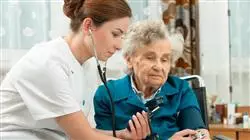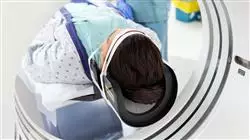University certificate
The world's largest faculty of nursing”
Introduction to the Program
You will learn the specific care required by patients with cerebrovascular pathologies and recognize the symptoms of stroke according to its location and etiology"

This program in Cerebrovascular Diseases and Neurological Oncology for Nursing addresses the different cerebrovascular diseases that exist and their impact on population mortality. Stroke is the most common cerebrovascular disease, which can cause severe disability in adults, and is the leading cause of mortality in women in different countries around the world. Therefore, stroke will be defined according to its location and etiology, addressing cerebral hemorrhages, cerebral venous thrombosis, cerebrovascular syndromes and transient ischemic attacks.
A fundamental topic when suffering a stroke will also be discussed, which is neurorehabilitation, the most up-to-date treatments and how it influences in increasing the affected patient's capacity for independence. The student will learn the importance of activating the Stroke Code and the treatment of acute stroke in Stroke Units. To improve the speed of care, the Stroke Code was created. We will describe how this code is activated, what is the circuit to be followed and how it is treated in the hospital emergency room and subsequently in the stroke unit.
In this case, the specific treatment will depend on the patient, the evolution of the process and the type of stroke. Since 2012, a highly specialized treatment called vascular neurointerventionism has been performed, which will be extensively detailed in the module. In all possible cases, management in specialized units called Stroke Units is recommended. Diagnostic measures, general care, specific treatment and control of complications are applied to ensure the best outcome for patients. A highly trained nursing team is essential for this purpose. In addition, a glossary of terms will be provided to enable the nursing staff to perform a correct neurological assessment of the patient.
Similarly, the definition of the most up-to-date treatments and specific nursing care in cerebrovascular pathologies and tumor processes is established in such a way that this knowledge is integrated to be able to perform a specific assessment by functional patterns and diagnose according to NANDA taxonomy, planning outcome criteria according to NOC taxonomy and nursing interventions according to NIC taxonomy.
Under the slogan "Time is brain", which reflects the importance of receiving medical and nursing care as soon as possible in the event of a stroke, the Stroke Code is activated. This Postgraduate diploma gives you all the guidelines to follow in the established protocol"
This Postgraduate diploma Cerebrovascular Diseases and Neurological Oncology for Nursing contains the most complete and up-to-date program on the market. The most important features of the program include:
- Development of more than 100 case studies presented by experts in neurological nursing. Its graphic, schematic and eminently practical contents, which are designed to provide essential
- scientific and assistance information for professional practice
- Latest developments in neurological nursing
- Contains practical exercises
- Theoretical lessons, questions to the experts and clinical cases for individual reflection
- Content that is accessible from any fixed or portable device with an Internet connection
- Multimedia content developed with the latest educational technology, which will allow the professional a situated and contextual learning, that is, a simulated environment that will provide an
- immersive learning programmed to train in real situations
Neurorehabilitation is essential after suffering a stroke, master the most up-to-date treatments and how they influence the patient's ability to be independent with this TECH program"
The program’s teaching staff includes professionals from the sector who contribute their work experience to this training program, as well as renowned specialists from leading societies and prestigious universities.
The multimedia content, developed with the latest educational technology, will provide the professional with situated and contextual learning, i.e., a simulated environment that will provide immersive training programmed to train in real situations.
This program is designed around Problem-Based Learning, whereby the professional must try to solve the different professional practice situations that arise during the academic year. For this purpose, the professional will be assisted by an innovative interactive video system created by renowned and experienced experts.
Study in depth the knowledge of brain tumors and understand the associated neurological complications in order to understand the treatments used in neuro-oncology perfectly"

This Postgraduate diploma in TECH allows you to combine your work and personal life with your studies, as it is 100% online and without timetable, so you can study it whenever it suits you best"
Why study at TECH?
TECH is the world’s largest online university. With an impressive catalog of more than 14,000 university programs available in 11 languages, it is positioned as a leader in employability, with a 99% job placement rate. In addition, it relies on an enormous faculty of more than 6,000 professors of the highest international renown.

Study at the world's largest online university and guarantee your professional success. The future starts at TECH”
The world’s best online university according to FORBES
The prestigious Forbes magazine, specialized in business and finance, has highlighted TECH as “the world's best online university” This is what they have recently stated in an article in their digital edition in which they echo the success story of this institution, “thanks to the academic offer it provides, the selection of its teaching staff, and an innovative learning method aimed at educating the professionals of the future”
A revolutionary study method, a cutting-edge faculty and a practical focus: the key to TECH's success.
The most complete study plans on the university scene
TECH offers the most complete study plans on the university scene, with syllabuses that cover fundamental concepts and, at the same time, the main scientific advances in their specific scientific areas. In addition, these programs are continuously being updated to guarantee students the academic vanguard and the most in-demand professional skills. In this way, the university's qualifications provide its graduates with a significant advantage to propel their careers to success.
TECH offers the most comprehensive and intensive study plans on the current university scene.
A world-class teaching staff
TECH's teaching staff is made up of more than 6,000 professors with the highest international recognition. Professors, researchers and top executives of multinational companies, including Isaiah Covington, performance coach of the Boston Celtics; Magda Romanska, principal investigator at Harvard MetaLAB; Ignacio Wistumba, chairman of the department of translational molecular pathology at MD Anderson Cancer Center; and D.W. Pine, creative director of TIME magazine, among others.
Internationally renowned experts, specialized in different branches of Health, Technology, Communication and Business, form part of the TECH faculty.
A unique learning method
TECH is the first university to use Relearning in all its programs. It is the best online learning methodology, accredited with international teaching quality certifications, provided by prestigious educational agencies. In addition, this disruptive educational model is complemented with the “Case Method”, thereby setting up a unique online teaching strategy. Innovative teaching resources are also implemented, including detailed videos, infographics and interactive summaries.
TECH combines Relearning and the Case Method in all its university programs to guarantee excellent theoretical and practical learning, studying whenever and wherever you want.
The world's largest online university
TECH is the world’s largest online university. We are the largest educational institution, with the best and widest online educational catalog, one hundred percent online and covering the vast majority of areas of knowledge. We offer a large selection of our own degrees and accredited online undergraduate and postgraduate degrees. In total, more than 14,000 university degrees, in eleven different languages, make us the largest educational largest in the world.
TECH has the world's most extensive catalog of academic and official programs, available in more than 11 languages.
Google Premier Partner
The American technology giant has awarded TECH the Google Google Premier Partner badge. This award, which is only available to 3% of the world's companies, highlights the efficient, flexible and tailored experience that this university provides to students. The recognition as a Google Premier Partner not only accredits the maximum rigor, performance and investment in TECH's digital infrastructures, but also places this university as one of the world's leading technology companies.
Google has positioned TECH in the top 3% of the world's most important technology companies by awarding it its Google Premier Partner badge.
The official online university of the NBA
TECH is the official online university of the NBA. Thanks to our agreement with the biggest league in basketball, we offer our students exclusive university programs, as well as a wide variety of educational resources focused on the business of the league and other areas of the sports industry. Each program is made up of a uniquely designed syllabus and features exceptional guest hosts: professionals with a distinguished sports background who will offer their expertise on the most relevant topics.
TECH has been selected by the NBA, the world's top basketball league, as its official online university.
The top-rated university by its students
Students have positioned TECH as the world's top-rated university on the main review websites, with a highest rating of 4.9 out of 5, obtained from more than 1,000 reviews. These results consolidate TECH as the benchmark university institution at an international level, reflecting the excellence and positive impact of its educational model.” reflecting the excellence and positive impact of its educational model.”
TECH is the world’s top-rated university by its students.
Leaders in employability
TECH has managed to become the leading university in employability. 99% of its students obtain jobs in the academic field they have studied, within one year of completing any of the university's programs. A similar number achieve immediate career enhancement. All this thanks to a study methodology that bases its effectiveness on the acquisition of practical skills, which are absolutely necessary for professional development.
99% of TECH graduates find a job within a year of completing their studies.
Postgraduate Diploma in Cerebrovascular Diseases and Neurological Oncology for Nurses
.
Would you like to focus your career in the care and treatment of cerebrovascular diseases and neuro oncology? TECH has the answer! With the Postgraduate Diploma in Cerebrovascular Diseases and Neurological Oncology for Nursing you will delve into the latest scientific advances in these areas, mastering the main techniques of diagnosis, care, care and treatment of pathologies such as stroke, brain tumors and paraneoplastic syndromes. Throughout the syllabus, you will have the development of multiple clinical cases presented by experts in Neurological Nursing.
Master the most advanced nursing care in neurological pathologies
.
Cerebrovascular diseases are one of the leading causes of disability and death worldwide, so it is essential that nurses are trained to provide comprehensive care to patients suffering from them. With this 100% online Postgraduate Diploma, you will be able to acquire the skills necessary for the comprehensive care of patients suffering from cerebrovascular diseases, from detection and diagnosis to treatment and follow-up.







